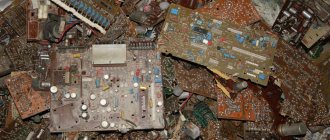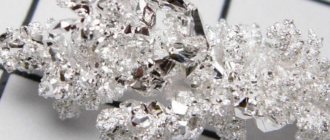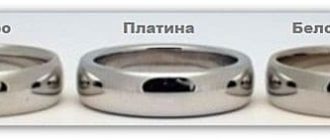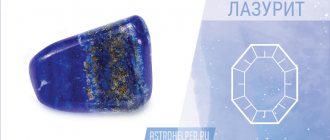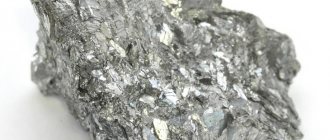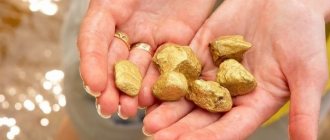Palladium
- a rare mineral, a noble metal of the platinum group, silver in color, not tarnished in air. Discovered by the English chemist and mineralogist W.H. Wollaston, who discovered palladium in native platinum in 1803. Malleable and malleable. More fusible compared to platinum, it is easily rolled and drawn into wire. Melting point 1552°C. Paramagnetic Soluble in HNO3, hot concentrated H2SO4 and aqua regia. Palladium has an extremely high affinity for hydrogen; in powder form it can absorb a volume of hydrogen 900 times greater than the metal’s own volume. Compared to other platinum metals, it is less resistant to oxidizing agents.
- Structure
- Properties
- Reserves and production
- Origin
- Application
- Classification
- Physical properties
- Optical properties
- Crystallographic properties
See also:
Silver
– structure and physical properties
PROPERTIES
Palladium is plastic; microadditives of nickel, cobalt, rhodium or ruthenium improve the mechanical properties of Pd and increase hardness.
Insoluble in water; density - 12.02 (20 °C, g/cm³); under special conditions it forms colloidal palladium and palladium black. Of all the platinum group metals, palladium is the most fusible. Melting point is 1554 °C (in some sources 1552 °C); boiling point about 2940 °C. Heat of fusion - 37.8 cal/g; specific heat capacity at 20 °C - 0.0586 cal/(g deg); electrical resistivity at 25 °C - 9.96 μOhm/cm; thermal conductivity - 0.161 cal/(cm·sec·deg). A paramagnetic material, that is, is magnetized in an external magnetic field in the direction of this field.
In its pure form, palladium has a beautiful silvery-white color. Like all noble metals, its color does not change over time.
Palladium in its pure form is a fairly soft metal. Its hardness is 373 MPa Brinell, which is approximately equal to the hardness of platinum (392 MPa) and exceeds the hardness of gold and silver (245 MPa). The hardness of pure palladium increases when cold worked by forging or rolling. During annealing, the hardness decreases again. Pure palladium cannot be used in jewelry; it will be extremely sensitive to mechanical stress. However, adding small amounts of other metals, especially nickel or ruthenium, to palladium significantly increases its hardness. For example, palladium 950 is used for the production of jewelry in Europe and North America, i.e. The jewelry contains 95% pure palladium. The remaining 5% is usually ruthenium or copper. In Russia, alloys of palladium with silver and nickel of 500 or 850 standard, and an alloy with copper of 850 standard are used to make jewelry. The wear resistance of palladium jewelry is approximately equal to that of platinum and is higher than that of gold and silver jewelry.
Where to find material
At home, the main source material for refining will be various radio components. By using it in alloys, on the basis of which manufacturers make microcircuits, the developers of the latter manage to significantly increase their service life.
Palladium can be obtained from KM capacitors. In them it is found in the form of an alloy with platinum. The metal is also included in other types of capacitors used in Russian (including Soviet) and foreign radio components. Depending on the type of electrical circuit and its operating conditions, the ratio of the initial components in the alloys may vary.
The precious metal in question is found very rarely in transistors. If it is used in such microcircuits, it is in small quantities. Therefore, transistors are not used in refining to obtain metal.
Palladium looks similar to silver and platinum, as all materials have the same light shade. Visually distinguishing them from each other can be difficult even for an experienced specialist. Materials can be separated using preheated nitric acid: platinum does not react with it. On the other hand, the latter dissolves in a mixture known as “royal vodka”. To carry out this reaction, the starting components must be heated.
RESERVES AND PRODUCTION
Geologists have calculated that palladium accounts for 6% of the Earth's interior. That is, there is twice as much of this noble metal in the depths as gold. Palladium is isolated from platinum, which means it is mined in the same deposits. These are located on the Kola Peninsula and the Urals. Deposits have also recently been explored near Norilsk. The platinum of these deposits contains almost half of palladium. Outside of Russia, the lands of Alaska, Australia, Colombia, Canada, and Africa are famous for the presence of valuable metal. The last two countries are rich in nickel ores. When processing them, palladium is also extracted. Therefore, it is Africa and Canada that lead in the production of this metal. Supplies of palladium in the world in 2007 amounted to 267 tons (including Russia - 141 tons, South Africa - 86 tons, USA and Canada - 31 tons, other countries - 9 tons). Palladium consumption in 2007 was 107 tons in the automotive industry, 40 tons in the electronics industry, and 12 tons in the chemical industry.
Palladium is mainly obtained by processing sulfide ores of nickel, silver and copper.
Why separate metal?
Many chemists use palladium isolated from radio components as a catalyst. Jewelers refine this metal to repair palladium jewelry. Some craftsmen sell the mined precious metal to pawn shops, which falls under Article 19.14 of the Code of the Russian Federation on Administrative Offenses.
Many are attracted by the fact that the cost of Pd on the precious metals market today exceeds the cost of gold. According to experts, this year the price of this element will rise, as demand significantly exceeds supply.
ORIGIN
Palladium occurs as an impurity in many sulfides and silicates of ultramafic and mafic rocks. Some coals are enriched with palladium up to 10%; increased concentrations are observed in manganese ores, phosphorites, and plant ash. Palladium content is elevated in ultramafic rocks and rocks containing Cu, Ni and Te sulfides. Usually found in nature as an impurity in native platinum, with which it forms a disordered solid solution; sometimes found in its placers in the form of rounded grains. As a rule, it contains impurities of platinum, iridium, gold, and silver. Palladium platinum contains 19-40% palladium, palladium stannoplatinum -17-21%, polyxene - up to 6%, ferroplatinum - up to 13%, iridium platinum - up to 4%. It can also be found as an admixture to native gold (in Brazil, for example, a rare variety of native gold (porpecite) was found, containing 8-11% palladium). It is formed in the zone of oxidation of primary sources of platinum and directly in placers as a result of supergene transformation of platinum minerals. In iron meteorites, there is up to 7.7 grams of substance per ton. palladium, in stone - up to 3.5 g. Since alluvial deposits of native palladium are very rare, the main raw materials for its associated production are sulfide ores of nickel and copper (Norilsk region, etc.)
Ways to isolate palladium from radio components
Palladium is the most chemically active element of all platinum group metals. There are several ways to obtain this metal:
- Electrolytic - using concentrated HCl.
- The etching method is to keep palladium scrap from other metals for a day in hydrochloric acid, then filter it.
- Refining.
Since it is by the method of refining, as a result of a sequential chain of chemical reactions, that pure Pd can be obtained, I will tell you in more detail about this method:
- Scrap palladium will likely contain several precious elements. Therefore, they will need to be identified in stages.
- All precious metals are dissolved in aqua regia - a mixture of concentrated nitric and hydrochloric acids in a ratio of 1:3. All radio components with potential palladium content are dipped into this solution. We remember about safety precautions - we protect our hands, eyes and respiratory organs.
- The dissolution process, depending on the amount of scrap, can last up to 2 days. The flask should be stirred periodically. If the solution turns burgundy, the presence of palladium is obvious.
- Next is the restoration of the substances we need. Pd can be reduced from solution with potassium iodide.
- To separate Palladium from Aurum, if it was part of the scrap, ammonia is added to the flask. Leave the liquid with dissolved metals for another 2 days.
- The next step is to filter the gold solution. Gold is reduced with zinc.
- And lastly: fill the palladium filtrate with a small amount of hydrochloric acid. We filter the resulting yellow-orange precipitate, wash it several times with water, then with alcohol, dry it, and as a result we obtain palladium powder, which can be melted using a gasoline or gas burner.
One of the options for refining palladium from radio components is shown in this video.
APPLICATION
Palladium is often used as a catalyst, mainly in the hydrogenation of fats and cracking of petroleum. Palladium chloride is used as a catalyst and for the detection of trace amounts of carbon monoxide in air or gas mixtures.
Palladium chloride is used in electroplating as an activating substance in the galvanic metallization of dielectrics - in particular, the deposition of copper on the surface of laminates in the production of printed circuit boards in electronics.
Palladium and palladium alloys are used in electronics for coatings that are resistant to sulfides (an advantage over silver). In particular, palladium is constantly consumed for the production of high-precision precision resistance rheochords (military and aerospace equipment), including in the form of an alloy with tungsten (for example, PdV-20M). The use in these units is due to the high wear resistance of palladium, which is ideal for its use in contact groups. By the way, rheochords made of palladium wire were widely used in civil equipment, and palladium in its pure form was used in the contacts of stepper switches of control-recording machines, in the contacts and strings of MKS (multiple coordinate connectors) of ATSC (automatic telephone exchanges coordinate) produced with 1982 to 1987 USSR. Palladium is also included in ceramic capacitors (type KM), with high temperature stability of the capacitance in high-frequency equipment for radio broadcasting, radio communications, and television.
In alloys used in jewelry (for example, to produce a gold-palladium alloy - the so-called “white gold”). Palladium, even in a small concentration in the alloy (about 1%), changes the color of the gold-based alloy from yellow to silver-white. The main palladium-silver alloys used in jewelry have silver grades of 500 and 850 (as they are the most technologically advanced for machining and are decorative). Commemorative coins are sometimes minted from palladium in limited editions.
Medical instruments, parts of pacemakers, and dentures are made from palladium and its alloys; In some countries, a small amount of palladium is used to obtain cytostatic drugs - in the form of complex compounds, similar to cis-platinum.
Palladium – Pd
| Molecular weight | 107.44 g/mol |
| origin of name | named in 1803 in honor of the asteroid “Pallas”, discovered almost simultaneously with palladium. |
| IMA status | valid, first described before 1959 (before IMA) |
Palladium scrap prices
Scrap prices depend on many parameters - purity, quantity, sample availability, brand popularity. If it is a pure element obtained through refining, there is a chance to sell it for a good price. In radio components, palladium is usually 500 fine, and its cost rarely exceeds 500 rubles per gram.
Reception points can evaluate the product individually, especially if the markings have been preserved. And some parts, such as capacitors, can be purchased by collectors at a cost that is several times higher than the cost of palladium in them. Therefore, before attempting to melt down scrap yourself, consult with specialists.
PHYSICAL PROPERTIES
| Mineral color | white |
| Stroke color | steel gray |
| Transparency | opaque |
| Shine | metal |
| Cleavage | No |
| Hardness (Mohs scale) | 4.5-5 |
| Strength | malleable |
| Kink | jagged |
| Density (measured) | 11.3 – 11.8 g/cm3 |
| Radioactivity (GRapi) | 0 |
| Magnetism | paramagnetic |
RECEIPT.
A solution of gold and platinum containing palladium, after isolating gold and platinum from it, is treated with ammonia according to the reaction: PdCl2+4NH3= [Pd(NH3)4Cl2] is obtained so-called. palladosamine, which is then re-dissolved in ammonia, reprecipitated with hydrochloric acid and calcined. Sponge palladium containing up to 99.9% Pd is obtained. This method allows you to get rid of a number of impurities that produce complex soluble ammonia salts. For finer purification, sponge palladium is dissolved in aqua regia, reprecipitated with ammonia, and palladium is obtained in the form of the salt Pd(NH3)2Cl6.
Palladium in ingots is supplied to the consumer in accordance with GOST 12360-66 and, in accordance with the chemical composition according to this GOST, two grades of palladium refined in ingots are established: PDA-1 (99.95%) and PDA-2 (99.90%). Palladium is supplied to the consumer in the form of rectangular ingots 100x65 mm, weighing no more than 3.5 kg. The surface of the ingot is processed by cutting and cleaned to a roughness of no more than RZ 80
Platinum
The substance is a chemical element, a native silver-white metal, very similar to silver, but unlike the latter, platinum is a refractory, acid-resistant, corrosion-resistant metal, due to which it is widely used in various industries, for the production of capacitors, resistors, switches, connectors in various devices and equipment. Scientists compare platinum to salt; it is impossible to do without it in electrical engineering, radio engineering, precision instrument making, and the aerospace industry. Almost no modern technology can exist without Pt. Platinum is used in alloys in its pure form.
Use of pure platinum
- Grids and cathodes in electrolysis, dies, winding wire, thermocouples, electrical resistance furnaces.
- Chemical industry - catalyst in the production of sulfuric and nitric acid, for the oxidation of ammonia, dehydrogenation, hydrogenation, alcohol reduction.
- Jewelry industry.
- Platinization of dishes, production baths and tanks.
Use of platinum in alloy
- Electronics industry – contacts, vacuum devices, electrodes, thermocouple wire.
- Chemical – catalysts, filters, electrodes, meshes.
- Medicine – dentistry, traumatology and surgery (prostheses, instruments).
This is only a small part of where this truly precious metal is used. The use of platinum is expanding in the automotive industry, where air purifiers and neutralizer filters are needed.
It is clear that palladium and platinum are not just precious metals, but also extremely necessary substances in many areas of production, and therefore our national economy needs them. The company buys various REC, devices containing Pt, Pd. If you want to offer us something, but are not sure how suitable it is for sale, contact our managers and clarify all questions regarding cooperation.
Hello, dear friends. Today we will talk about whether palladium is contained in radio components, where exactly one should look for light platinum and find out which method of treating it is most effective.
The richest deposits
Although large amounts of palladium are found in pieces of meteorites that fall to earth, the bulk of production comes from ore deposits. They provide about 98% of the world's metal reserves.
In the world
The Bushveld Complex (South Africa) is the world's largest palladium deposit. Here, prospectors find up to 40% of the world's precious metal reserves.
In much smaller quantities it is also extracted into:
- Lac des Iles (Canada);
- Stillwater (USA);
- Great Dike (Zimbabwe).
In Russia
The copper-nickel deposits that are part of OJSC MMC Norilsk Nickel are the largest metal suppliers in Russia:
- Oktyabrskoe;
- Talnakhskoe;
- Norilsk-1.
Their total profit is more than 40% of the global one.
History of appearance
Palladium is a ductile mineral with a silvery-white color. Due to its properties, palladium looks like platinum. However, it is immediately worth noting that it belongs to the category of platinum minerals, so this similarity is easy to explain.
In the first years of the XIX century. English chemist W. Wollaston, purifying platinum from impurities, obtained a precipitate of an unexpected color. This gave reason to assume the existence of a new chemical element, which was called “palladium”.
What followed was a series of intriguing events. Through a mineral dealer, Wollaston anonymously put the ingot up for sale, claiming that it was a new metal - palladium. There were those who wanted to refute the discovery of a new chemical element. Scientific debates either subsided or resumed, but remained inconclusive.
To stir up interest, Wollaston, again anonymously, offered a prize to anyone who could create this metal artificially, but no one was able to do it. And only in 1805, at a meeting of the Royal Society, the chemist reported on how palladium was obtained and that he was the author of anonymous publications.
Examples of refining
Refining is carried out using various methods. To highlight the material at home, the best choice would be:
Electrolysis requires highly concentrated sulfuric acid. It replaces the electrolyte. Lead is used as the cathode, and the anode is an electrical component from which the required material is released. During the procedure, the original copper and brass alloys remain intact. After electrolysis, palladium with various impurities is released. To remove them, the metal is placed in hydrochloric nitric acid.
Before starting the procedure, a voltage of 11-13 volts is applied to a container filled with electrolyte. Exposure to electric current leads to the formation of powder or flakes in the vessel. It is in this form that palladium is released.
Notes
- Michael E. Wieser, Norman Holden, Tyler B. Coplen, John K. Böhlke, Michael Berglund, Willi A. Brand, Paul De Bièvre, Manfred Gröning, Robert D. Loss, Juris Meija, Takafumi Hirata, Thomas Prohaska, Ronny Schoenberg, Glenda O'Connor, Thomas Walczyk, Shige Yoneda, Xiang-Kun Zhu.
Atomic weights of the elements 2011 (IUPAC Technical Report) // Pure and Applied Chemistry. — 2013. — Vol. 85, no. 5. - P. 1047-1078. — DOI:10.1351/PAC-REP-13-03-02. - ↑ 123456789101112131415
Palladium // Chemical encyclopedia: in 5 volumes / Knunyants I. L. (chief editor). - M.: Great Russian Encyclopedia, 1992. - T. 3: Med-Pol. - pp. 440-441. — 639 p. — 48,000 copies. — ISBN 5-85270-039-8. - Periodic table on the IUPAC website
- Voitkevich V.G.
Origin and chemical evolution of the Earth / ed. L. I. Prikhodko. - M.: Nauka, 1973. - 168 p. - “Methodology for carrying out work on the comprehensive recycling of secondary precious metals from used computer equipment” (APPROVED BY GOSTELECOM RF 10/19/1999)
- Sberbank website.
- Norilsk metal - What do we know about palladium?
- Bulletin of foreign commercial information, No. 95, 08.23.08, p.12.
- Thomson Reuters GFMS | Analytics and content for metals professionals | Thomson Reuters Eikon
- [1]
Ceramic capacitors
To carry out refining, it is necessary to prepare expensive components and appropriate utensils. Therefore, in order to avoid additional costs, it is recommended that before starting work, prepare a sufficient amount of starting materials, which contain a lot of palladium.
In modern electronics the content of this material is small. And in order to obtain metal in a relatively large volume, you should stock up on the required number of ceramic capacitors: KM-3, KM-4, KM-5 and KM-6. It is they, according to experts, that meet the above conditions. However, ceramic capacitors are expensive.
You can find CM in electronics produced during the Soviet era. Ceramic capacitors have previously been used in:
- analog technology;
- computers;
- generators;
- measuring devices (E7-14, P2-73);
- oscilloscopes (C-114, 116 and others) and so on.
Ceramic capacitors are the optimal starting material for refining. They can be found in Soviet electrical engineering or contact people involved in gold production. The latter often do not pay attention to palladium.
How to recognize a fake by the seams
Typically, gold consists of component parts, each of which is soldered together. For example, if we are talking about chains, bracelets, etc. The soldering can be seen even on the rings, but you will have to look long and hard.
Where components are soldered, real gold has different, iridescent colors. If they are not there, and the accessory is made in one color, then this is a fake! It will also not be difficult to examine this flaw, and even a beginner can cope with this matter.
Reviews
Katerina: “It just so happens that I love jewelry, especially rings. Knowing this passion of mine, my family constantly gives me something new. I also have several rings, both palladium and platinum. And I like the first ones much more. Firstly, they are lighter and do not feel much when worn. Secondly, I like their color better. Well, if you buy it yourself, palladium rings are much cheaper than platinum.”
Svetlana: “Palladium jewelry is good for everyone, except for one thing - it’s almost impossible to find them. I had to scour more than one store and online resources to find what I needed. In theory, it was possible to buy the same white gold based on palladium, but in fact very few of them are made. Basically, everything is a regular gold alloy with rhodium plating. I wish there was a better choice."
